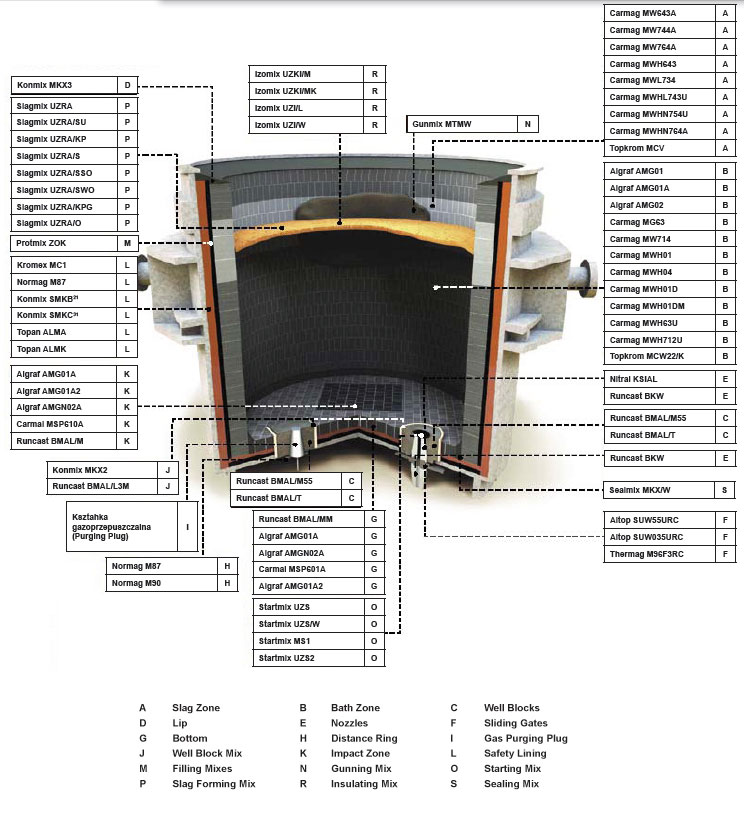Ferrous Industry
Electric Arc Furnaces | Steel Ladles | Steel Degassers
Steel Ladles
Ladles in the steel plant environment are primarily required to contain and transport molten steel from the melting unit to the casting facility. In the recent past this was the sole purpose of the ladle, and the refractory requirements were undemanding, allowing the use of low alumina bloating fireclay as the working lining. Backing linings were also built using fireclay materials, and the low thermal conductivity, and heat capacity allowed the ladles to be used without preheating.
Modern day steel ladles operate in harsher conditions, where temperatures are higher, steel is stirred in the ladle, slag chemistries are more variable, and residence times are longer. All these factors have caused a radical change in ladle design, with great dependence on zoning either by quality or thickness to overcome preferential wear and achieve a balanced life at the lowest possible cost per tonne.
Development of furnace technology was most marked during the 1960's with the advent of mini mills, and continuous casting, and the modern day furnace bears little resemblance to its forebears.
Future designs for ladles will follow the current trends, with greater reliance upon the ladle for refining, deoxidation and degassing. Residence times will be long owing to the treatment, and electrode heating in the ladle will be necessary to maintain the temperatures required for casting. Demands upon the refractory will continue to be high requiring continuous development to maintain and improve performance.
Ladle Refining Furnaces
Ladle refining furnaces have become increasingly common in both EAF and BOS shops, where primary melting is carried out in either the arc furnace or converter, and further heating and treatment in the ladle. Refining in the ladle may comprise deoxidation, desulphurisation and alloy trimming using a variety of calcium aluminate synthetic slags. All ladle refining furnace provide heat to the steel by electrode heating usually with stirring using either electromagnetism or gas plugs. After final heating in the ladle, most ladles are subjected to degassing using either RH or DH degassers, and a common feature of the ladle refining furnace is one of long residence and high temperature.
Refractory applications vary widely depending upon both the operation and practice, and each may show individuality.
Bottom
The ladle bottom is invariably constructed from either fired alumina, carbon bonded dolomite or magnesite with the provision of an impact or tapping pad, in carbon bonded alumina graphite with metal additions. The severity of the operation in terms of residence times often sees the replacement of the bottom at mid campaign, usually coinciding with a slag line repair.
Sidewalls
Sidewalls of ladle refining furnaces sometimes exhibit preferential wear associated with the method of stirring, requiring either increased thickness panels, or improved refractory quality.
The ladle sidewalls may be constructed using either carbon bonded dolomite, carbon bonded magnesite or carbon bonded magnesite carbon. All basic ladle linings however have very high thermal conductivity and heat capacity and thorough and effective preheat with sufficient soak time is essential.
Slaglines
Slags associated with ladle refining furnaces are usually high in calcium aluminate, and contain fluxing agents such as fluorspar, making them particularly aggressive. Slag line refractory materials are usually magnesite carbon with at least 10% flake graphite and containing metal additions. In particularly severe applications recourse is made to magnesite carbon based upon large crystal size magnesite, and in the most arduous conditions magnesite carbon based upon fused magnesia.
The action of bubblers in the ladle bottom may also have a profound effect at the slagline particularly if the gas stream is close to the sidewall. In these cases severe localized erosion may occur giving rise to premature failure of the slagline.

